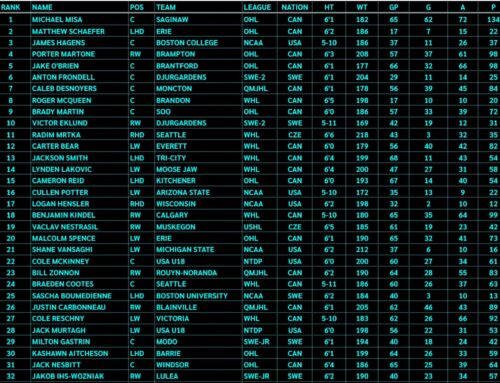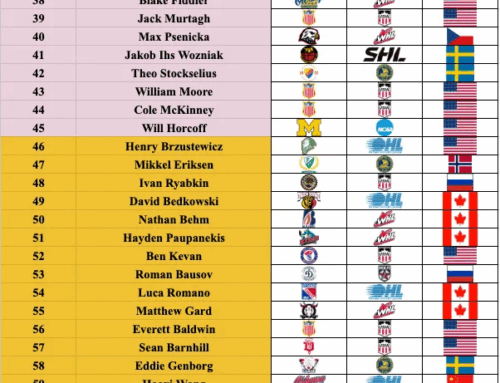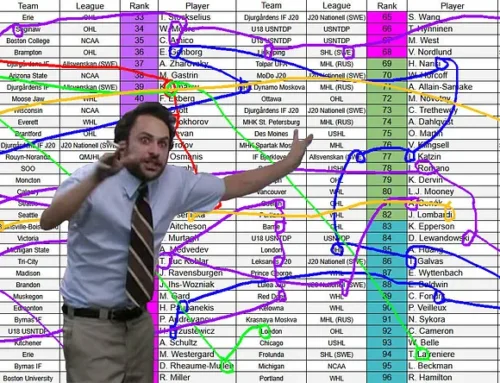Draft Class Deep Dive: LHD Jake Sanderson
Tony Ferrari
2020-07-06
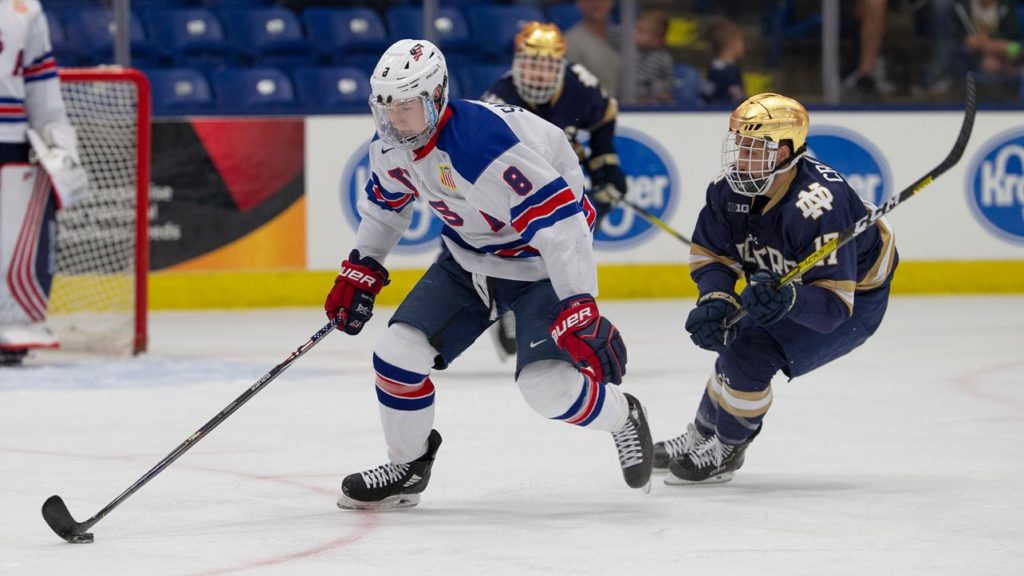
Jake Sanderson of the U.S. NTDP skates up ice against Notre Dame. Courtesy of NHL.com
When the season began last fall, the U.S. National Team Development Program U18 team had a lot of question marks scattered across the roster. Depending on who you asked, players such as Thomas Bordeleau, Ty Smilanic, and Tyler Kleven were all players who had the potential to be selected in the first round of the 2020 NHL Draft. Jake Sanderson was another name that seemed to have a shot but the defender was young for the draft class and showed a very raw toolset last season playing for the U.S. NTDP U17 team. Fast-forward to March 2020, a pandemic hits and shuts the season down as Sanderson was beginning his ascent into the top-ten on most draft boards.
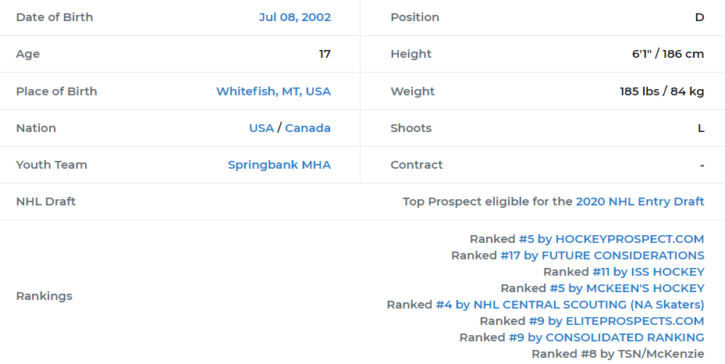
Player Information courtesy of Elite Prospects
Sanderson’s season was on the rise from about January on and his play seemed to really hit its stride coming out of the Biosteel All-American game where the prospect world seemed to take notice. He was able to show off his skating, offensive game, and defensive game in one marquee event. The player that came into the year with a fairly raw toolset finally had the opportunity to show that his tools had matured and become much more refined in the first few months of the season. Jake Sanderson began to work his way to the forefront of the conversation as it pertained to the second-best defender in the draft class. Two months later in March, he has slowly worked his way into the conversation with Jamie Drysdale as the top blueliner overall.
Sanderson has laid his claim to the title of top defensive blueliner. His rise has made him a near sure-fire top-ten selection in mid-October when the NHL expects to have the draft. The questions range from whether he will be able to contribute offensively enough or whether a team may be making a mistake by selecting a player whose calling card is the defensive side of the game. Can Jake Sanderson get to that next level offensively? Can his raw tools translate into a solid two-way game?
Skating and Mobility
While not flashy, Sanderson is a strong skater. He doesn’t have the same elite dynamism as a skater that was highlighted in the Jamie Drysdale Deep Dive but is stronger on the puck and on his feet as he weaves through the neutral zone with high-level edge work and good acceleration. He has the ability to use his edgework to manipulate forecheckers and his pull away speed to attack the offensive blueline. In the clip below, Sanderson (#8 in blue) collects the puck in the corner. He opens himself up to the entirety of the defensive zone and faints passing behind the net. Once the forechecker bites, Sanderson is able to pull the puck across his body and immediately begin moving up ice. This small amount of separation allows for the NTDP defender to carry the puck through the neutral zone. As he approaches the blueline, he passes the puck off to Thomas Bordeleau (#9) at the wall and then continues his path down the nearside of the slot. His path draws defenders deep, opening up a passing lane for Bordeleau to send a cross-ice pass leading to a goal.
The above display of skating is a perfect example of how Jake Sanderson can utilize his smooth skating. One of the keys to Sanderson’s mobility is the fact that he is an extremely fluid skater. His transitions and pivots are crisp and controlled, rarely looking like his footwork is lagging behind or getting too far ahead of him. In the next clip, we get a look at his ability to track back into the defensive zone and then calmly turn up ice and control transition because of his skating. When he stops up behind his own net, he is able to survey the ice. When he moves through the defensive zone, he is closed in on along the wall but slips away from the pressure. As he approaches the blueline, he passes the puck off and allows his teammates to work deep into the offensive zone.
Where Sanderson lacks a bit of the dynamism and excitement that Drysdale brings, he brings a stable and sturdy presence as a puck carrier and skater. He does an excellent job of skating through contact and protecting the puck. His quick feet and excellent footwork allow him to be a highly aggressive player when attempting to keep the puck in the offensive zone. As we see below, the young American blueliner has the fluidity in his footwork that allows him to change the angle at the blueline and patrol the offensive zone. When he pinches down the wall, he is able to shake off the defensive player with ease and move the puck below the goal line and then retreat back to his positioning. The ease of his mobility allows him to choose his spots with high efficiency.
Offensive Tranistions
With such fluid skating, as seen above, Sanderson has quietly become one of the best transition defenders when moving the puck up the ice. He plays in the USHL which may give his numbers a bit of a boost in comparison to the CHL but courtesy of InStat, Sanderson averages 4.85 zone entries per game which are ahead of Drysdale (3.84), Kaiden Guhle (2.85) and William Wallinder (2.55). All three defenders are widely considered strong in transition and while they all play in different leagues, Sanderson averages more zone entries by a not-insignificant margin.
When it comes to breaking the puck out of his zone, the NTDP captain is even more impressive as he averages 7.31 zone exits or breakouts per game. When looking at the same group of defenders, Drysdale (6.0) comes closest followed by Guhle (5.74) and Wallinder (4.31). While Wallinder’s numbers do improve when you take away his games at the Allsvenskan level, they still do not come close to Sanderson’s. What is particularly encouraging about Sanderson’s transition numbers are that they are virtually unchanged when you separate his play against the USHL vs. NCAA competition.
Sanderson is an extremely smart breakout artist. His ability to utilize a number of his tools is what makes him such an efficient player in transition. We’ve seen him use his skating ability to move the puck up the ice and that is truly his strongest trait in the offensive transition game. He gets the puck into the neutral zone with his skating and then makes the decision to either pass or skate the puck into the offensive zone. While doesn’t use his passing to exit the zone as often as some of his counterparts – 44.1% of his breakouts are passes compared to 61.3% for Drysdale and 62.5% for Guhle – he is adept at putting the puck on his teammate’s stick efficiently when he needs too.
With excellent skating ability, Sanderson’s offensive transition plays often lead to offensive chances. Sanderson is an intimidating force as a puck carrier because of how quickly he can build up speed at back off opposing defenders. He isn’t afraid to skate at his counterpart allowing them to make the first move and then making a move whether it be passing off or utilizing his skilled, yet inconsistent, puck handling. In the play below, Sanderson identifies the open space along his side of the neutral zone. As he steps up, he receives the pass from his defensive partner and begins his assault on the opposition. Utilizing a play he made his bread and butter this year, Sanderson passes off at the blueline and then gets a return pass as he skates by the defender who steps up at the blueline. This gives Sanderson the option of stopping up, circling behind the net or attacking the net as he does in this video.
This type of attack in transition is where Sanderson is at his best. His ability to break into the offensive zone and attack at a high pace is what really seemed to take a step as the year wore on. His confidence in his ability to take chances and recover grew and his play driving ability came to the forefront.
Defensive Transitions
Sanderson is a very aggressive defender in transition. His ability to step up in the neutral zone with good timing and the ability to win his battles or disrupt the opposition’s path on a regular basis is what stands out. Sanderson has excellent defensive awareness and rarely finds himself on the wrong side of the puck, consistently recognizing when to track back in the neutral zone and when to step up into his man. In the clip below, Sanderson begins mirroring the attacker in the neutral zone and as soon as the pass is sent up ice, he steps up to break it up just outside of the offensive blueline. The puck bounces back out to Sanderson at center ice and he immediately identifies a teammate pushing up ice and sends a pass his way. After a quick trip in the offensive zone, Sanderson wins a puck race back into his defensive zone and is able to elude the forecheck, not once but twice, bringing the puck under control.
The above play illustrates how important Sanderson’s effortless skating is to his game and just how crisp his edge work and agility are. Without his high-end footwork, Sanderson likely has to track the loose puck deep into his own zone, bringing the level of threat to an unnecessary level, even if he has control of the puck. Being able to evade pressure the way he does here is integral to a defender’s ability to make a good play up ice. If Sanderson wants to be as aggressive as he is in the neutral zone, then he will need to continue to get faster and stronger as he develops.
A defender’s job in the modern-day NHL is to prevent an offense from even having a chance to begin. The best rearguards in today’s game are excellent blueline play stoppers. The understanding of when to step up and when to angle off along with the willingness to do either shape Sanderson’s zone entry defense. As we can see in the following clip, the American defender effortlessly sweep the puck off of the attacking forward’s stick as they cross the blueline. In one motion, Sanderson has the ability to pull the puck away from danger and corral it himself. Stopping up behind the net and allowing his team to get set, Sanderson then breaks up the ice. Again using the give-and-go tactic at the offensive blueline, Sanderson battles for the loose puck in the corner until help arrives and then gets back into position to defend should the opponent come out with the puck.
Many modern-day defensemen tend to lack physicality, especially the highly skilled and puck-moving blueliners, but Sanderson has shown that he is more than willing to engage physically. His ability to close off defenders along the wall in impressive as he utilizes good body positioning and an active and accurate stick is among the best in the class. Below we have an example of his ability to pivot and close on an attacker. He gets the puck back and makes a short, safe pass to begin the breakout.
Stepping into an attacking player is a risky move at times and only becomes riskier in open ice. While it doesn’t seem to be his go-to move, he has shown a willingness to do it. He is successful because of his good balance on his feet and he is aware of how the play is developing. He doesn’t throw massive hits that take him out of the play, rather he steps into the player and impedes their path while staying upright himself.
In-Zone Defensive Play
The area of the game that young defenders always seem to have an issue with is their in-zone defensive play. While Sanderson isn’t perfect here, there is a lot to work with. He has a high-IQ and understands positioning in his zone. He protects the net-front quite well and knows when to leave his post to engage along the wall. There were moments where he seemed to be overpowered a bit by bigger, stronger forwards, particularly against NCAA teams. One of the most impressive parts of Sanderson’s defensive game is the rate he wins challenges, a statistic courtesy of InStat that accounts for one-on-one battles. His 66.3% challenge percentage surpasses just about all of the top defenders in the class. With Drysdale (57.5%). Guhle (60.4%), Wallinder (57.0%), and Braden Schneider (59.5%) all coming in well behind him, Sanderson is in a class of his own when it comes to winning one-on-one battles. The other factor is how often a player is engaging in ‘Challenges’. Sanderson is involved in more defensive and neutral zone challenges per game than any player on this list with the exception of Guhle and Schnieder in the defensive zone – 10.3 for Sanderson and Schneider while Guhle paces the group with 11.0, while most other players from the 2020 draft class sit in the 6-8 defensive zone challenges per-game range.
When it comes to dealing with backpressure and retrieving the puck in his own zone on a dump in, Sanderson makes good decisions. He shows a great deal of patience and rarely rushes passes. He has the strength on his skates to withstand some physical contact, showing the ability to work through forechecks to ensure that the puck is moving up ice. As we can see above, Sanderson allows the netminder to collect the dump-in behind the net and provides a passing option. When the forecheck comes in, Sanderson receives the pass and then leans into the forecheck, throwing a reverse hit of sorts. He turns up ice and fights through traffic to get a pass to the wing in the neutral zone.
Body positioning is the name of the game in the defensive zone. If a defender can ensure that his body is between the puck and the opponent, he will more often than not come away with the puck. Sanderson does an excellent job of this. The video below is a bit of a prequel to one of the clips above. The NTDP defender does a good job of getting himself in a good position in the corner to put the puck behind the net for his partner. He then tracks to the front of the net and stays aware of his surroundings. He slides in behind the net to aid in the breakout and then puts his skating on display.
A weakness for many young defenders in their own end is board play. While defensemen are getting better in space, their board play has suffered as the game has gone away from the physical, slower-paced game of yesteryear. At times, teams like the Boston Bruins or St. Louis Blues have been able to shut down skilled teams because of their ability to lean on their opponents and really win the game along the boards. While he will need to continue to get stronger, Sanderson shows excellent ability breaking up the opposition’s cycle game and filtering the puck to his teammates. As we can see below, Sanderson fights to get between the puck and the forechecker, pokes the puck free, and lets his teammate do the work to move it up ice. Winning small battles like this may not go noticed by the average fan but coaches love seeing it.
In general, Sanderson will need to get stronger and become more consistent with his ability to utilize his body as he begins to face bigger and stronger competition when he attends the University of North Dakota next year. He will also need to choose his spots a bit better when choosing to leave the net front to chase a player behind his net or into the corner. Oftentimes he gets a bit overeager and will follow his defensive partner into a board battle, leaving the slot unprotected. With some minor tweaks to his defensive positioning that may just come down to maturing a bit, Sanderson should be a stout defensive player at the next level.
Offensive Capabilities
There is no doubt that Sanderson’s offensive game is not as dynamic as the like of Drysdale or a player like Jérémie Poirier. The top-ranked American flashes some of the attacking offensive style that has become a bit more accustomed to the modern NHL game. Sanderson’s strength and production come in transition offensively. As previously mentioned, Sanderson works the give-and-go at the offensive blueline extremely well. If he gets a good return pass, it gives him the option to drive to the net, set up a play on the half wall or circle in behind the net. Sanderson plays an efficient and effective offensive game that may not ‘wow’ regularly but gets the job done. He has an 85.6% pass completion percentage which looks favorable when compared to his fellow 2020 draft-eligible prospects with Drysdale and Wallinder coming in at 85%, Guhle at 86%, and Schnieder sitting at 82%.
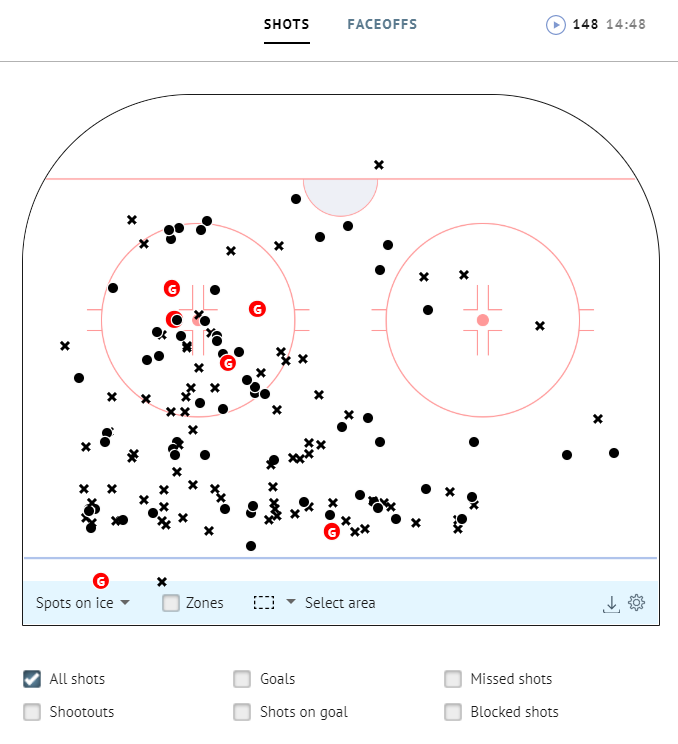
Jake Sanderson Shot Chart courtesy of InStat
He is also a dangerous puck carrier when he enters the offensive zone with control. He uses his speed to back off defenders and find a passing option. If he is leading the rush, he has no hesitation in driving to the net to try and cash in on a rebound or return pass. In the clip below, Sanderson rushes up ice with his crisp skating, cutting through the neutral zone with ease. Upon entering the offensive zone, he finds a teammate across ice and drives the slot. When the puck is centered, he makes a good effort in tight on the net.
Where Sanderson doesn’t get credit is as a contributor from the blue line. Sanderson may not be the dynamic presence that some other defensemen are but he is far more capable offensively than the vast majority of blueliners with his defensive acumen. The offensive zone is where Sanderson still has a bit of the ‘raw’ tag still. He doesn’t always take the play given to him but when he does, he has the tools to make a difference. As the season went on, this became more consistent. With the confidence gained from his ever-improving play, Sanderson became a bit more daring with the puck on his stick.
While he isn’t a big shot defender, he does have a good wrist shot. When he is able to fire it while on the move it can be extremely effective at finding the back of the net or creating a rebound for his teammates. In the clip below, we can see Sanderson playing facilitator at the top of the offensive zone. Once he realizes that the defenders are staying stagnant and are barely even adjusting to the passes, he attacks a bit of open space in the bottom half of the left faceoff circle. Once there, he fires a shot and beats the netminder with ease. Attacking on the move is key for a player like Sanderson who relies on changing the angle and locating his shot well.
The flashes of some dynamic ability were there. When they happened, it was generally because Sanderson was able to use his skating and skill. Sanderson’s speed is dangerous when he gets on his horse. In the play below, we see Sanderson join the offensive rush as the third attacker. As he skates through center ice he passes off to Matthew Beniers, the typical Sanderson give-and-go at the blue line. When he drives to the backside of the net, he pulls the defender off course. When the return pass from Beniers comes, Sanderson has the sense of mind to send it back across the grain as the goaltender and defenders all fade towards him. Beniers makes no mistake, putting the puck in the net. This is the kind of flash that leads some scouts to believe that Sanderson, as one of the younger players in the draft class thanks to a summer birthday, could have some more offensive potential locked in there.
Sanderson also has very good puck protecting ability and very good hands. He has the ability to skate around the offensive zone and protect the puck from defenders, giving himself time to find his teammates. In the clip below, Sanderson gains the offensive zone with control of the puck – a seemingly regular occurrence as we go through his game tape – and then circles the zone. He is able to keep the puck protected and work his way around the zone. His pass winds up offside but not due to him throwing an errant pass by any means. If Sanderson can regularly put these tools together, he could develop into a very good offensive player, even if he never gets to a truly dynamic level.
The U.S. NTDP U18 team was not the same kind of force that last year’s team was or next year’s team is slated to be. With a higher quality of teammate, Sanderson may have had a bit more of a productive year when looking at the traditional numbers. His ability to be an option in transition and move the puck from the defensive zone to the offensive zone with control is a skill that many NHL teams will covet in today’s game.
Closer To #1 Than We Think
Coming into the 2019-20 season, the belief that Jamie Drysdale was far and away the best defender may have been the prevailing thought but Sanderson has at least made it a discussion. His defensive metrics are better in just about every category. He has transition numbers that also rival the best in the class. With a summer birthday (July 8, 2002) he has a ton of room to grow and develop. The fact that he is on the younger side for the draft class explains why he may have been a bit of a raw package coming into the year. By seasons end, the rawness of his game became more refined. He developed confidence in his ability to contribute offensively and began to be a play driver from the back end.
Jake Sanderson is the epitome of the modern-day defensive defenceman. He has the defensive IQ and skill to shut down offensive chances whether it be disrupting a cycle in-zone or thwarting the opposition’s transition game. He has the ability to move the puck up ice, with his passing or his skating, and began creating offensive chances off the rush with regularity. His powerplay quarterbacking is good as long as he is the facilitator and not relied upon as a true dynamic play generator. He should fit in well on a second powerplay unit while anchoring the top penalty kill unit as well.
All-in-all, Sanderson is the total package. The young American blueliner may be the best transitional defenseman in this draft class. He may lack a bit of the dynamism and flash that come with a player like Drysdale but he is efficient and effective. He is a better player in his own zone and needs less work when it comes to structure in his game and strength on his frame. Sanderson has the size, speed, and skill to be a difference-maker at the next level in all three zones. If his offensive game plateaus as a 30-40 point defender, that will be more than enough as he is going to provide so much value in his own zone. When draft day arrives in October(?), Sanderson may end up hearing his name called whenever the first team decides to take a defenseman, a thought that would have been laughable in September.
********
Thank you for joining us for the latest Deep Dive for the 2020 NHL Draft, be sure to check out the Jamie Drysdale Deep Dive. Shot chart and statistics such as passing percentage and challenge rate courtesy of InStat Hockey, a top of the line video and scouting platform. For more from InStat, follow them on Twitter. For more on prospects and the NHL Draft, you can follow Tony Ferrari on Twitter.
For your fantasy hockey needs, the DobberProspects Fantasy Prospect Report and Fantasy Guide are the best sources to get you ahead of the game in your league whether you play in a simple year-to-year league or you’re involved in a decade long keeper league, the DobberProspects’ Fantasy Guides are your one-stop-shop for winning your league!



